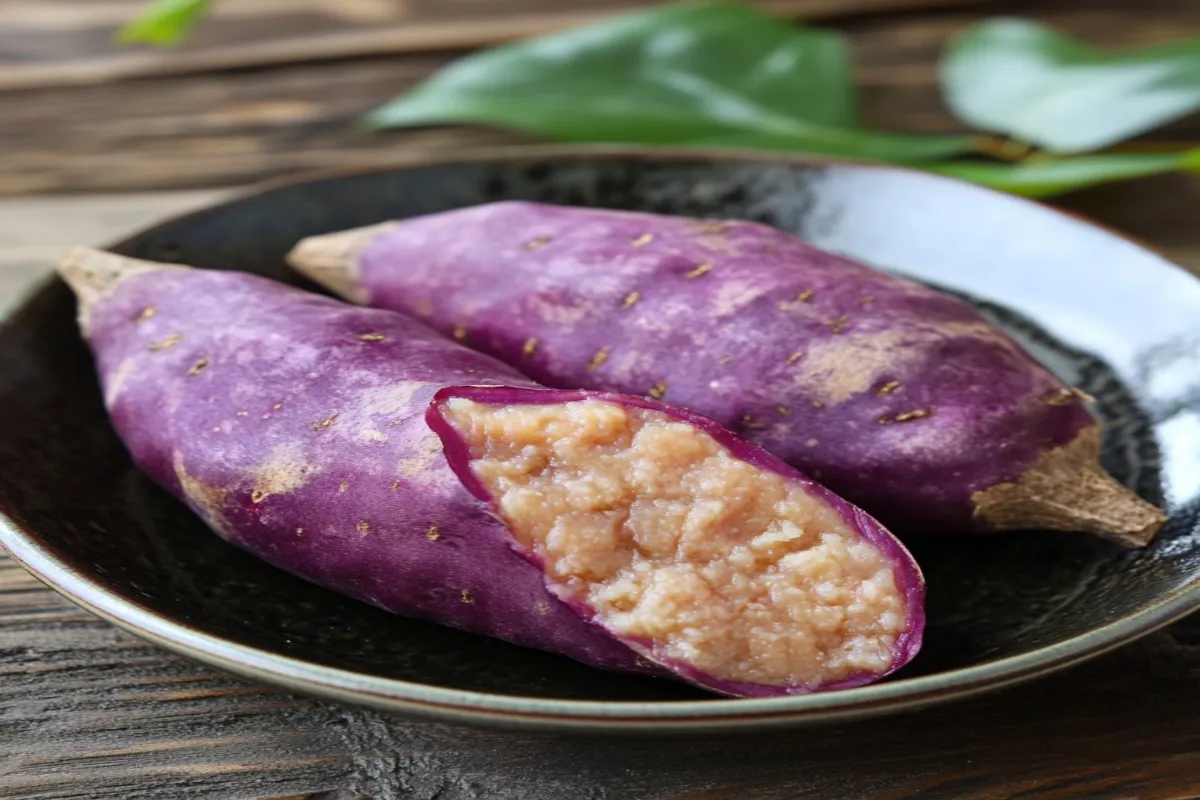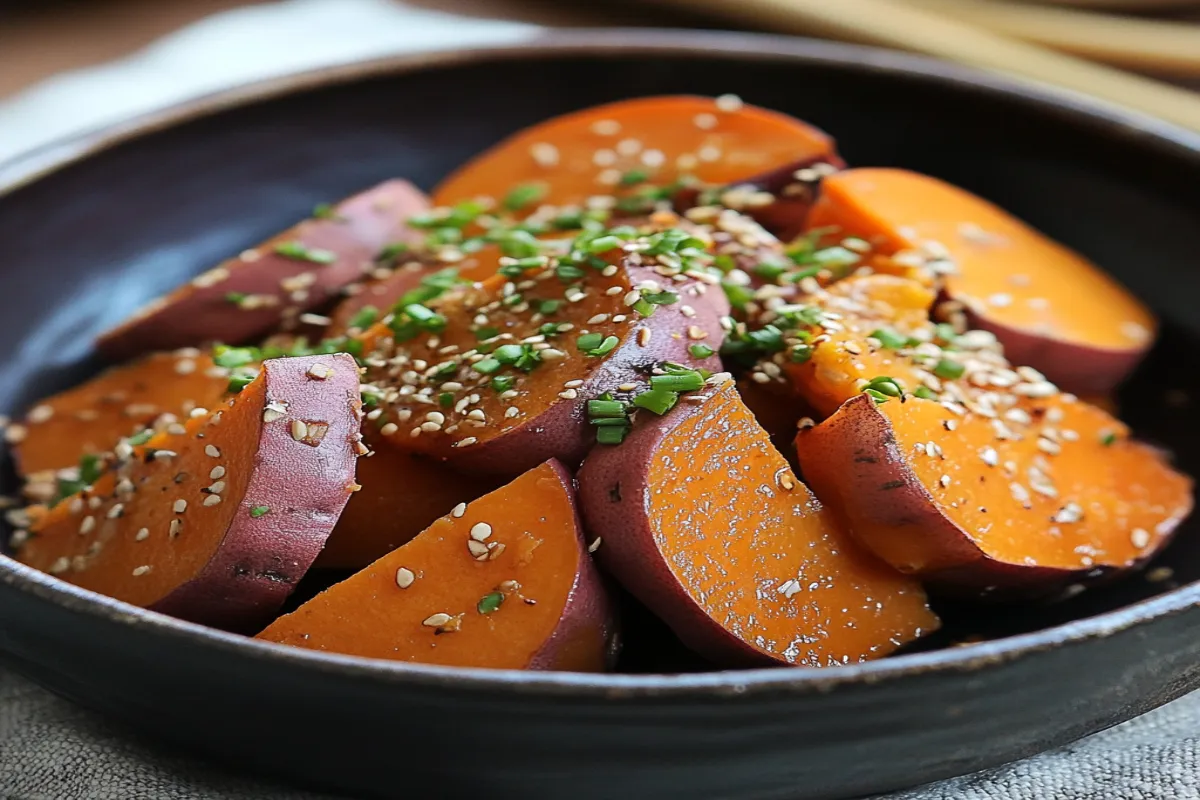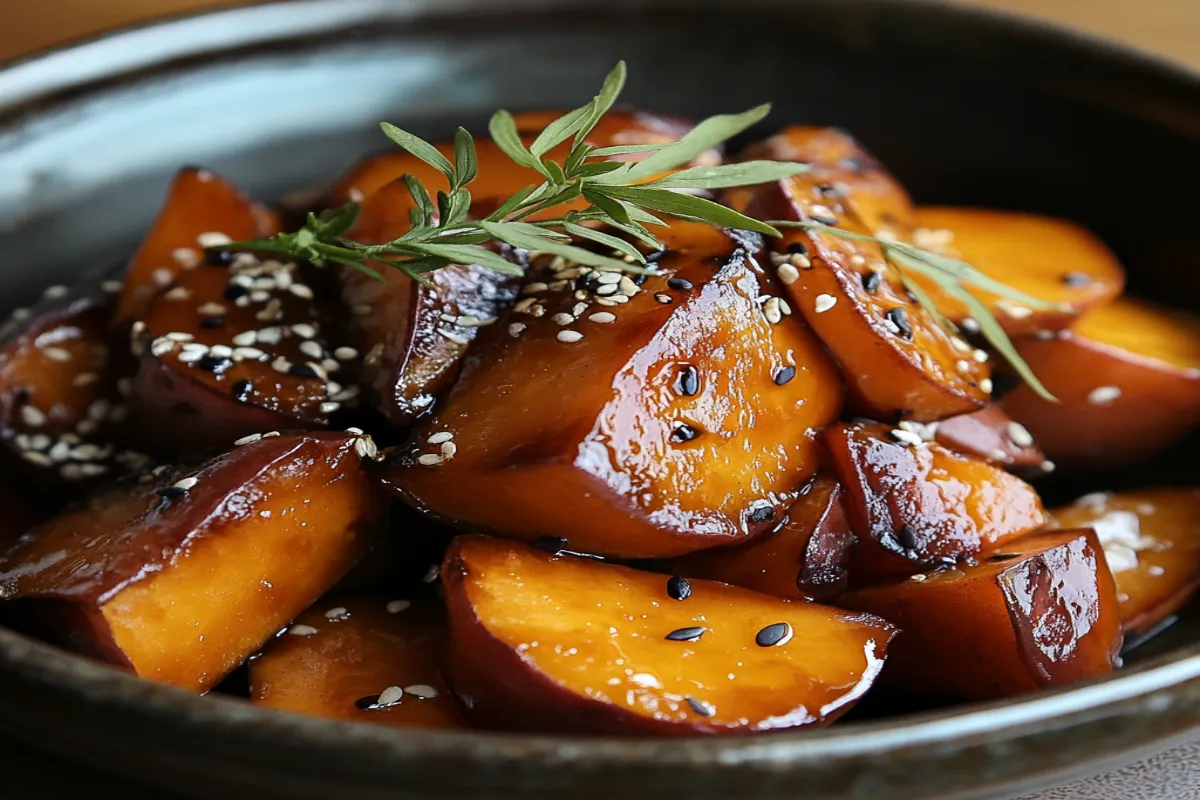Sweet potatoes are a beloved staple in many kitchens around the world. Their natural sweetness, coupled with their versatility, makes them a go-to ingredient in countless dishes. But have you ever tried Murasaki Sweet Potato? This Japanese variety of sweet potatoes stands out with its unique appearance, delightful flavor, and impressive nutritional profile. Whether you’re looking to introduce a new ingredient to your meals or want to explore healthier alternatives, Murasaki Sweet Potato deserves a spot on your plate.
Murasaki Sweet Potato, with its deep purple skin and white flesh, offers a subtle sweetness that’s less intense than traditional orange sweet potatoes. Their texture is firmer, making them ideal for roasting, mashing, and even baking. Not only are they delicious, but they’re also packed with nutrients, including fiber, vitamins, and antioxidants, making them a healthy addition to any diet.
In this article, you’ll learn everything you need to know about preparing a perfect Murasaki Sweet Potato dish. From selecting key ingredients to the step-by-step cooking process, I’ll walk you through the recipe. Additionally, you’ll find tips for achieving the best results, presentation ideas, and even variations to cater to different dietary preferences.
Key Ingredients for Murasaki Sweet Potatoes
The beauty of cooking with Murasaki sweet potatoes lies in the simplicity of the ingredients. These naturally flavorful tubers don’t need much to shine in a dish. Here are the key ingredients required for the recipe:
Murasaki Sweet Potatoes
The star of the dish, Murasaki sweet potatoes have a slightly nutty flavor with a mild sweetness. When selecting Murasaki sweet potatoes, look for ones with smooth, unblemished skin. Avoid any with soft spots, which may indicate they’re overripe. Murasaki sweet potatoes differ from regular sweet potatoes in both texture and taste. Their firmer flesh holds up well in a variety of cooking methods.
Substitutions for Murasaki Sweet Potatoes:
If you can’t find Murasaki sweet potatoes, you can substitute them with traditional orange-fleshed sweet potatoes or purple sweet potatoes (Okinawan). While the flavor will differ slightly, both alternatives work well in this recipe. However, keep in mind that regular sweet potatoes are sweeter, and the purple Okinawan variety has a denser texture.
Olive Oil
Olive oil is a great choice for roasting Murasaki sweet potatoes. It helps crisp up the outer layer while maintaining the moisture inside, resulting in a perfect texture. You can also use avocado oil or coconut oil as alternatives if you prefer.
Salt and Pepper
Simple seasonings like salt and pepper enhance the natural flavors of the Murasaki sweet potatoes. A pinch of sea salt brings out the subtle sweetness, while freshly ground black pepper adds a bit of spice.
Garlic
For added flavor, garlic is an optional ingredient you can use. Fresh garlic cloves roasted alongside the potatoes offer a mild, nutty flavor that pairs beautifully with the earthiness of Murasaki sweet potatoes.
Fresh Herbs (Optional)
Herbs like rosemary, thyme, or parsley can elevate the flavor profile of your roasted Murasaki sweet potatoes. Rosemary, in particular, complements the subtle sweetness of the potatoes, giving them an aromatic finish. You can also experiment with other herbs like oregano or basil, depending on your preference.
Butter (Optional)
For a richer flavor, you can finish the dish with a small amount of butter. This is entirely optional and can be substituted with plant-based alternatives like vegan butter or even a drizzle of tahini for those who want a dairy-free option.
Honey or Maple Syrup (Optional)
For those who like an extra touch of sweetness, adding a light drizzle of honey or maple syrup just before serving enhances the natural sugars in the potatoes. This can be especially delightful for a festive meal or special occasion.
How to Make Murasaki Sweet Potatoes

Cooking Murasaki sweet potatoes is both simple and rewarding. Whether you’re roasting them for a side dish or mashing them for a more substantial meal, the process is straightforward. Follow these steps for perfectly cooked Murasaki sweet potatoes.
Step 1: Prepare the Potatoes
First, start by washing the Murasaki sweet potatoes under cool running water to remove any dirt or debris. Since they’re typically cooked with the skin on, it’s important to scrub them clean. After washing, pat them dry with a towel.
Step 2: Preheat the Oven
Preheat your oven to 400°F (200°C). Roasting is the best way to bring out the natural flavors of Murasaki sweet potatoes, and a hot oven ensures they get crispy on the outside while remaining tender on the inside.
Step 3: Cut the Potatoes
Once your potatoes are clean, cut them into even-sized wedges or rounds. Cutting them into uniform pieces ensures even cooking. If you prefer smaller bite-sized pieces, you can also cube them.
Step 4: Season the Potatoes
Place the cut Murasaki sweet potatoes in a large mixing bowl. Drizzle with olive oil, then sprinkle with salt and pepper. Toss them well to ensure all pieces are evenly coated. If you’re using garlic or fresh herbs, add them at this stage.
Step 5: Roast the Potatoes
Spread the seasoned Murasaki sweet potatoes in a single layer on a baking sheet lined with parchment paper. Be sure not to overcrowd the pan, as this can lead to steaming rather than roasting. Roast for 25-30 minutes, flipping halfway through to ensure both sides get crispy and golden brown.
Step 6: Check for Doneness
After about 25 minutes, check the potatoes for doneness. They should be fork-tender, with a slightly crispy exterior. If they need more time, continue roasting in 5-minute intervals.
Step 7: Serve
Once roasted to perfection, remove the Murasaki sweet potatoes from the oven and transfer them to a serving platter. If desired, you can garnish with fresh herbs or a drizzle of honey or maple syrup for added sweetness. Serve immediately while hot.
Tips for Perfecting Murasaki Sweet Potatoes
Cooking the perfect Murasaki sweet potatoes is all about attention to detail. Here are some tips to help you master this recipe:
Tip 1: Keep the Skin On
Murasaki sweet potato skin is not only edible but also packed with nutrients. Leaving the skin on during cooking helps retain moisture and adds a nice texture to the dish. Plus, the purple skin provides a beautiful contrast to the white flesh when served.
Tip 2: Use High Heat for Roasting
Roasting Murasaki sweet potatoes at a high temperature ensures they become crispy on the outside while staying tender inside. If you prefer an even crispier texture, try broiling them for the last 2-3 minutes of cooking, but be careful not to burn them.
Tip 3: Toss Midway Through Cooking
Flipping or tossing the potatoes halfway through the roasting process guarantees even browning on all sides. This simple step can make a big difference in the final texture of your potatoes.
Tip 4: Season After Roasting (For Extra Flavor)
For an extra layer of flavor, try adding a sprinkle of flaky sea salt or a dash of smoked paprika after roasting. This will enhance the already savory notes of the potatoes and give them an extra pop of flavor.
Tip 5: Experiment with Cooking Methods
While roasting is a popular method, Murasaki sweet potatoes can also be steamed, boiled, or even mashed. If you’re looking for a softer texture, boiling or steaming is a great option. For mashed Murasaki sweet potatoes, cook them until tender, then mash with butter, salt, and a touch of cream for a creamy, comforting side dish.
Presentation and Serving Suggestions for Murasaki Sweet Potatoes

Once your Murasaki sweet potatoes are roasted to perfection, it’s time to think about how to present and serve them. With their vibrant purple skin and creamy white flesh, they make for an eye-catching dish on any table.
Plating Techniques
Serve your Murasaki sweet potatoes in a large, shallow serving dish to show off their beautiful colors. If you’ve roasted them with garlic and herbs, leave those elements on the platter to add visual interest. For a more sophisticated presentation, place them in individual ramekins for each guest, topped with a sprig of fresh rosemary.
Garnishes
For a visually appealing finish, sprinkle the roasted potatoes with fresh herbs like parsley, thyme, or rosemary. You can also add a light drizzle of olive oil or a touch of honey to enhance the natural sweetness and shine. For a festive presentation, top with a sprinkle of pomegranate seeds or toasted nuts like almonds or pecans for added texture and color.
Serving Suggestions
Murasaki sweet potatoes pair well with a variety of main dishes. Serve them alongside roasted chicken or grilled fish for a balanced, nutritious meal. If you’re hosting a vegetarian or vegan dinner, these potatoes can complement a hearty grain salad or a warm lentil stew. Additionally, they make a great side dish for holiday meals like Thanksgiving, where they offer a unique alternative to traditional sweet potato dishes.
Drinks to Complement the Dish
When it comes to pairing drinks with Murasaki sweet potatoes, lighter beverages work best. Try serving them with sparkling water infused with lemon or cucumber for a refreshing option. For a more robust meal, herbal teas like mint or chamomile provide a delicate balance to the earthy flavors of the potatoes.
Variations and Dietary Adaptations for Murasaki Sweet Potato
One of the best aspects of Murasaki Sweet Potato is how easily you can adapt the recipe to suit different tastes and dietary needs. Here are some variations and adaptations to try:
Vegan Murasaki Sweet Potato
To keep the Murasaki Sweet Potato recipe vegan, simply use olive oil or coconut oil for roasting and skip the butter. You can also try a dairy-free butter alternative if you prefer a richer flavor. For added protein, consider tossing the roasted potatoes with cooked chickpeas or serving them with a side of hummus.
Gluten-Free Murasaki Sweet Potato
This recipe is naturally gluten-free, making it a great option for anyone with gluten sensitivities. Just be sure any additional ingredients or garnishes you use, like sauces or seasonings, are also gluten-free.
Low-Carb Murasaki Sweet Potato
While sweet potatoes do contain natural carbohydrates, Murasaki Sweet Potato is a nutrient-dense option for those following a lower-carb diet. To reduce the carb content further, serve them alongside a protein-rich dish like grilled chicken or tofu to balance the meal.
Spicy Murasaki Sweet Potato
For those who love a bit of heat, consider adding a pinch of red pepper flakes or cayenne pepper to the seasoning mix before roasting the Murasaki Sweet Potato. You can also drizzle the finished dish with a spicy sriracha mayo or a tangy hot sauce for an extra kick.
Sweet Murasaki Dessert Potatoes
If you’re in the mood for a sweeter variation, transform Murasaki Sweet Potato into a dessert by roasting them with cinnamon, nutmeg, and a drizzle of maple syrup. Serve them with a dollop of whipped cream or a scoop of vanilla ice cream for a decadent treat.
FAQs About Murasaki Sweet Potatoes
1. What is the difference between Murasaki sweet potatoes and regular sweet potatoes?
Murasaki sweet potatoes have a deep purple skin and white flesh, while regular sweet potatoes typically have orange flesh. Murasaki sweet potatoes are also less sweet and have a firmer texture compared to traditional orange sweet potatoes.
2. Can I eat the skin of Murasaki sweet potatoes?
Yes! The skin of Murasaki sweet potatoes is completely edible and is packed with fiber and nutrients. Just be sure to wash them thoroughly before cooking.
3. How do I store Murasaki sweet potatoes?
Store Murasaki sweet potatoes in a cool, dry place away from direct sunlight. Avoid storing them in the refrigerator, as this can cause them to become hard and lose flavor.
4. Are Murasaki sweet potatoes healthy?
Yes, Murasaki sweet potatoes are rich in fiber, vitamins A and C, and antioxidants. They’re a healthy addition to any meal and provide a good source of energy.
5. Can I use Murasaki sweet potatoes in desserts?
Absolutely! Murasaki sweet potatoes work well in both savory and sweet dishes. You can use them in pies, cakes, or even as a base for a sweet mash.
6. What dishes pair well with Murasaki sweet potatoes?
Murasaki sweet potatoes pair well with roasted meats, fish, and vegetarian dishes. They also make an excellent side for holiday meals or as part of a Mediterranean-inspired spread.
Conclusion
Murasaki sweet potatoes are a versatile and nutritious ingredient that can be used in a wide variety of dishes. With their firm texture, subtle sweetness, and beautiful purple skin, they stand out both in flavor and appearance. Whether you’re roasting them as a simple side dish, mashing them for a comforting meal, or transforming them into a sweet dessert, Murasaki sweet potatoes offer endless possibilities in the kitchen.
Now that you’ve learned how to prepare and serve Murasaki sweet potatoes, it’s time to give this recipe a try in your own kitchen. Don’t forget to experiment with the different variations and adapt the dish to suit your preferences. Enjoy!

